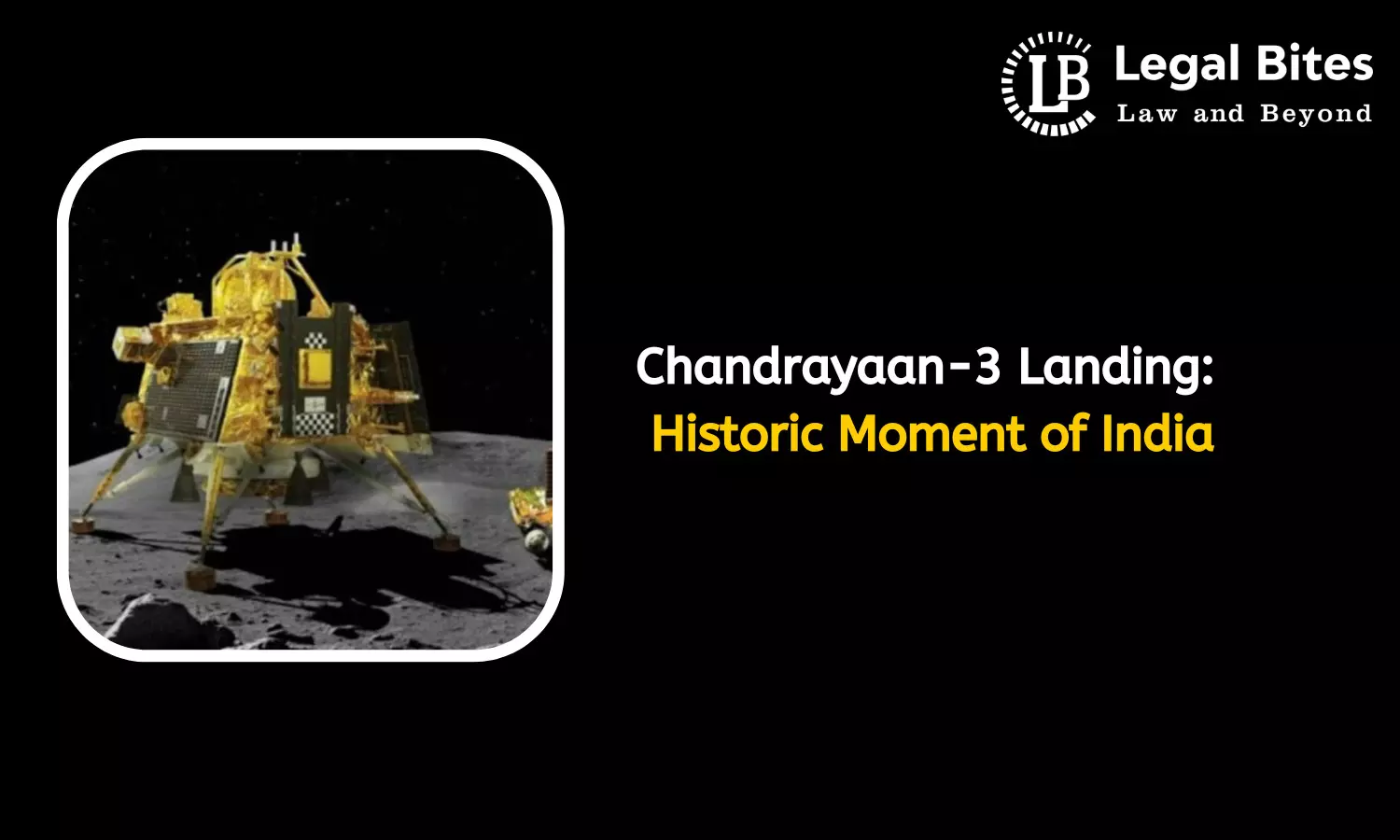Chandrayaan-3 Landing: Historic Moment of India | #Must Know
Here's all about August 23, 2023 when India achieved a historic milestone by becoming the first nation to successfully land its Chandrayaan-3 spacecraft near the lunar south pole.

Here's all about August 23, 2023 when India achieved a historic milestone by becoming the first nation to successfully land its Chandrayaan-3 spacecraft near the lunar south pole.
Chandrayaan-3 Landing: Important Facts
The historic landing of an Indian spacecraft in close proximity to the lunar south pole elicited enthusiastic acclaim at several gatherings held around the country. According to Sreedhara Panicker Somanath, the director of the Indian Space Research Organisation, the successful landing of the Vikram lander from the Chandrayaan-3 spacecraft near the lunar south pole at 6 pm marks a significant milestone in space exploration, since it is the first instance in history of any space mission achieving this feat by any country.
On August 23, India achieved the significant milestone of successfully executing a soft landing on the lunar surface using the Lander Module (LM) of its third lunar mission, Chandrayaan-3. This accomplishment places India in an exclusive group of nations, including the former Soviet Union, the United States, and China, who had previously achieved this feat.
The Chandrayaan-3 mission was launched on July 14, further solidifying India's presence in lunar exploration. In his address commending the ISRO team, Prime Minister Modi emphasised that the accomplishment of India's lunar mission extends beyond national boundaries. He highlighted the global resonance of the principle of "One Earth, One Family, One Future," which encapsulates the inclusive approach adopted by India. Both the Mars and Moon missions are grounded on the same human-centred worldview. Consequently, this achievement is collectively celebrated by the whole of the human population.
The Mission Operations Complex (MOX) of the ISRO Telemetry, Tracking, and Command Network (ISTRAC) in Bengaluru saw exuberant festivities after the successful touchdown of the lunar lander at exactly 6:03 p.m. Subsequently, the Rover was effectively deployed from the Lander, with the purpose of conducting in-situ chemical analysis of the lunar terrain. The Lander and Rover possess scientific payloads designed to perform study on the lunar surface, with a mission duration of one Lunar day, equivalent to 14 Earth days. The Indian government anticipates that the achievement of a successful landing would serve as a catalyst for private investment in space launches and related satellite-based enterprises, making the current time very opportune.
As the spacecraft approached the region, which experts assert may potentially harbour significant quantities of frozen water and scarce substances, individuals around the country were captivated by televised broadcasts. India has successfully achieved the historic milestone of landing near the south pole of the Moon, marking its first lunar surface exploration with the deployment of its Moon rover. According to the space agency, the rover deployed on Chandrayaan-3 has successfully disengaged from the lander, signifying a significant milestone in India's lunar exploration endeavours.
The Vikram lander successfully executed its landing as anticipated on Wednesday evening. India has achieved a significant milestone by successfully conducting a soft landing on the Moon, placing it in the esteemed company of countries such as the United States, the former Soviet Union, and China. The Vikram lander's payload included the rover Pragyaan, weighing about 26 kilogrammes (56 pounds), which was sent to the Moon.
The Panels situated on a certain side of the Vikram spacecraft were activated to initiate the deployment of a ramp. This ramp had the purpose of facilitating the descent of the Pragyaan rover onto the lunar surface. The deployment was scheduled to occur after the dust particles, which were stirred up during the landing that took place the previous night, had settled.
The next mission aims to conduct a comprehensive examination of the craters and rocks, capturing visual documentation in the form of photographs and videos, which will afterwards be sent to Earth. During the BRICS summit in South Africa, Prime Minister Narendra Modi was seen displaying the Indian flag and proclaiming, "This vocalisation signifies the triumph of a novel India." We are now seeing an unprecedented occurrence that is unlikely to occur again in our lifetime. In the week before the scheduled descent, a notable upsurge of anxious anticipation permeated across India. In order to facilitate a seamless arrival, churches and mosques conducted prayer services. The mission was ceremoniously inaugurated by Hindu monks who performed the ritual blowing of conch shells along the banks of the Ganges in Varanasi.
The Indian populace commemorated their momentous achievement of the first landing at the southernmost point of the Earth, often known as the South Pole, as well as their fourth successful landing on the moon. These significant milestones were joyously observed amidst vibrant celebrations on the streets on the evening of Wednesday. Just before to touchdown, the lander executed a sequence of intricate manoeuvres, including a transition from a horizontal to a vertical orientation and a deceleration from a velocity of 3,730 miles per hour to almost zero.
Ensuring precise alignment of the angle and velocity at this juncture was of utmost importance. If a substantial force had been exerted, the lander would have toppled. If the level of force exerted had not been sufficient, it is plausible that the lunar landing may have failed to occur at the intended location on the moon's surface.
During India's last lunar mission in 2019, the lander encountered a critical issue during its last manoeuvre, resulting in its failure to successfully adjust its position and instead colliding with the lunar surface. In the 1960s and 1970s, the Apollo missions successfully reached the moon within a few days. On July 14, the Indian spacecraft Chandrayaan-3, named after the Sanskrit term for "moon craft," was launched from Sriharikota, located in southern India. The rockets used by India exhibit a somewhat lower level of potency in comparison to the rockets utilised by the United States during the same period. In contrast, the spacecraft executed a sequence of orbital manoeuvres around the Earth to accumulate velocity before commencing its trajectory towards the moon, spanning a duration of one month.
The rover, termed Pragyaan, derived from the Sanskrit term for knowledge, is anticipated to be deployed from the lander's underside via a ramp, with the objective of conducting a surface exploration of the moon for a duration of two weeks, contingent upon the successful execution of the mission. The primary objectives of this mission were the acquisition of visual data, conducting geological and origin-related analyses of Earth, as well as investigating the presence of water ice.
The potential presence of abundant water ice on celestial bodies might potentially facilitate the establishment of future human missions since it could serve as a valuable resource for extracting oxygen and fuel. The southern polar region, characterised by its lack of visibility from Earth and its topographical features consisting of craters and trenches, is seen by several scholars as an optimal site for a prospective outpost.
What are the objectives and goals of the Chandrayaan-3 mission?
The next Chandrayaan mission will build upon the achievements of its predecessor. According to the official website of the Indian Space Research Organisation (ISRO), the Chandrayaan mission has three principal objectives:
- To demonstrate the feasibility of achieving a gentle and secure lunar landing.
- The purpose of this study is to elucidate the operational mechanisms of the lunar rover, Rover, and to conduct tests inside their respective natural environments.
Chandrayaan-3 comprises an indigenous Lander module (LM), Propulsion module (PM), and Rover. The primary aim of Chandrayaan-3 is to develop and demonstrate advanced technologies that will be essential for future interplanetary missions. According to the Indian Space Research Organisation (ISRO), the Lander incorporates a range of advanced technologies to effectively achieve the mission's goals.
Both laser and radio frequency (RF) altimeters are used in the application of Mission. Velocimeters are devices used to measure the velocity or speed of an object. The use of a Horizontal Velocity Camera and Laser Doppler Velocimeter in the context of landers is discussed in this section. The focus is on the kinematics and acceleration aspects of these devices. The proposed device is an accelerometer and inertial measurement unit (IMU) that utilises laser gyros as its primary sensing mechanism.
The mechanical propulsion techniques used in this study include controllable attitude thrusters with a thrust capacity of 58N, as well as throttle-able engines with a thrust capacity of 800N. The field of electronics encompasses the study and application of electrical circuits and devices that manipulate and control. The acronym NGC is an abbreviation for the term "navigation, guidance, and control which helps in the Process of Developing a Powered Descent Trajectory and its Software Components Identifying and Mitigating Hazards: The present mechanism focuses on the development of a Landing-Site Risk Assessment and Mitigation Imaging System, using a customised algorithm.
The lunar mission undertaken by India, known as Chandrayaan-3, is the nation's third endeavour in this domain and is widely regarded as a very consequential undertaking. Chandrayaan-3 is a very cost-effective space expedition, with a budget that is lower than the expenses used in the production of a significant cinematic endeavour.
According to K Sivan, the previous Chairman of ISRO, the total expenditure for Chandrayaan-3 amounts to Rs. 615 crore. Approximately 215 crore Indian Rupees were allocated towards the development of the lander, rover, and propulsion systems, while an estimated 365 crore Indian Rupees were invested in the launch operations. The recent successful landing of India's lunar mission, which targeted the south pole, is unexpected considering Russia's unsuccessful attempt to reach the moon after 47 years. Russia's Luna-25 spacecraft encountered a loss of control and ultimately crashed, leading to its mission being classified as a failure.
According to the head of Roscosmos, the state-controlled space company in Russia, the failure of the lunar study project might be attributed to the significant gap in research activities since the last Soviet expedition to the moon in 1976. The Union of Soviet Socialist Republics (USSR), the United States of America (USA), and the People's Republic of China (PRC) have each achieved successful soft landings on the lunar surface. Notably, these landings were accomplished in distinct geographical locations.
The Government led by Prime Minister Modi, which espouses nationalist ideals, is keen on emphasising India's growing prominence as a technical and space force after its ascent to become the world's fifth-largest economy in the previous year. The potential for an increase in Modi's popularity leading up to an important upcoming general election next year might be facilitated by a successful lunar trip. This achievement aligns with his vision of a rising India solidifying its standing among the international elite.
With Russia's unsuccessful mission and the emergence of China as a regional rival in the realm of space exploration, there has been a significant increase in hopes for a triumphant landing. China has formulated a strategic objective to dispatch human beings to the lunar surface during the concluding years of this decade. Furthermore, in the month of May, China successfully executed a mission including a crew of three individuals who were dispatched to its orbiting space station. The success of Chandrayaan-3 has led to an expansion of opportunities for those with an interest in space travel. The individuals who have shown exceptional dedication and courage in their scientific, professional, and engineering pursuits, therefore enhancing the reputation of India, are often regarded as heroes inside the nation.
References
[1] Chandrayaan-3: India lunar rover Pragyaan takes a walk on the Moon, Available Here
[2] Chandrayaan-3 Lander on the Moon | Updates, Available Here
[3] Historic Moment for India and ISRO: Key Achievements of Chandrayaan-3 Soft-Landed, Available Here

